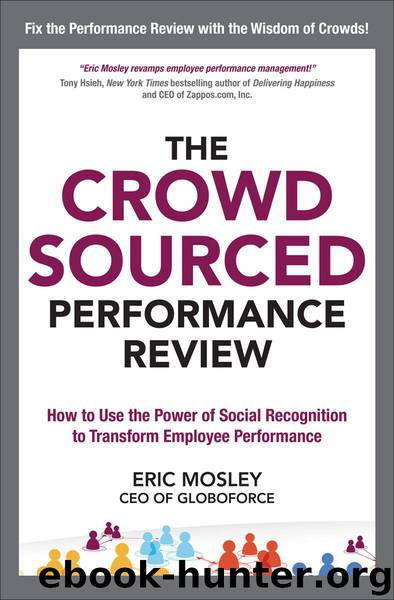The Crowdsourced Performance Review: How to Use the Power of Social Recognition to Transform Employee Performance by Eric Mosley

Author:Eric Mosley [Mosley, Eric]
Language: eng
Format: mobi, epub
Publisher: McGraw-Hill
Published: 2013-05-12T14:00:00+00:00
The Heroic Leader Meets Dunbar’s Number
Worldwide, organizations celebrate the heroic leader—the man or woman whose vision and will create (and presumably enforce) a particular culture. Business media have glorified leaders such as Lee Iacocca of Chrysler, Bill Gates of Microsoft, Steve Jobs of Apple, Lou Gerstner of IBM, and Herb Kelleher of Southwest Airlines. Each built a social architecture to support a cultural vision, and this was a key development because each of these leaders left a lasting company after their time at the helm ended.
Moving from Top-Down to Bottom-Up
According to research firm Gartner, social recognition programs can help improve performance while decreasing reliance solely on manager and executive feedback. In the report, Gartner managing vice president Jim Holincheck wrote, “Leading organizations will start to move toward more bottom-up feedback, recognition and rewards.” Managers can see the level of frequency of recognition and performance feedback for individual employees. As a result, “Senior executives can use this data to see if manager performance decisions align with what coworkers indicate through their actions.”6
Today’s business leaders, from Amazon’s Jeff Bezos to Facebook’s Mark Zuckerberg and Google’s Larry Page, are celebrated for their cultural vision as well as their technical acumen. Today’s leaders stress a culture of accountability, openness, speed, and teamwork that reflects the interdependent nature of their work, and they are relentlessly focused on performance management, from their notoriously demanding job interviews to performance reviews.
Jack Welch led GE through enormous changes—the Work-Out program for breaking down bureaucracy and hierarchy and Six-Sigma processes are just two he oversaw—and his vision, uncompromising standards, and astute use of media aided his success. GE was and is a vast, worldwide organization with hundreds of thousands of employees in scores of countries. He couldn’t meet with every employee to persuade each one to perform to his standards in his way. He needed a methodology and a structure that would nurture the values he deemed most important. So he posited a set of principles that defined how work would be measured, evaluated, and judged. Leveraging the existing social architecture, Welch improved communication and impressed every employee with his determination to fight for his values.
Social architecture doesn’t require a public figure like Welch for it to be enormously effective. Some of the most successful companies in the world have had a succession of “quiet” CEOs. Johnson & Johnson, for example, expresses its values in “Our Credo,” a statement that describes its responsibilities to doctors, nurses, patients, families, employees, communities, and, finally, shareholders. Outlined are specific behavioral guidelines (“Compensation must be fair and adequate, and working conditions clean, orderly, and safe”) that are flexible enough to apply across countries, businesses, and cultures.
When a large environment is aligned along just a few values, there is little ambiguity. A hundred signals a day promote their adoption. (Any manager or line worker can determine whether a workplace is “clean, orderly, and safe.”) And a hundred times a day, people at Johnson & Johnson can recognize the right values in action.
Executive Insight
“The middle 70 percent are managed differently.
Download
The Crowdsourced Performance Review: How to Use the Power of Social Recognition to Transform Employee Performance by Eric Mosley.epub
This site does not store any files on its server. We only index and link to content provided by other sites. Please contact the content providers to delete copyright contents if any and email us, we'll remove relevant links or contents immediately.
Tools of Titans by Timothy Ferriss(8162)
Change Your Questions, Change Your Life by Marilee Adams(7575)
Deep Work by Cal Newport(6828)
Man-made Catastrophes and Risk Information Concealment by Dmitry Chernov & Didier Sornette(5883)
Playing to Win_ How Strategy Really Works by A.G. Lafley & Roger L. Martin(5788)
Digital Minimalism by Cal Newport;(5593)
Big Magic: Creative Living Beyond Fear by Elizabeth Gilbert(5562)
The Slight Edge by Jeff Olson(5323)
Ego Is the Enemy by Ryan Holiday(5236)
The Motivation Myth by Jeff Haden(5131)
Stone's Rules by Roger Stone(4995)
The Laws of Human Nature by Robert Greene(4937)
Tuesdays with Morrie by Mitch Albom(4610)
Eat That Frog! by Brian Tracy(4396)
Rising Strong by Brene Brown(4348)
Skin in the Game by Nassim Nicholas Taleb(4128)
The Money Culture by Michael Lewis(4033)
Bullshit Jobs by David Graeber(4003)
Skin in the Game: Hidden Asymmetries in Daily Life by Nassim Nicholas Taleb(3873)
